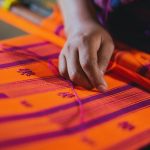Are you tired of dealing with stubborn creases in your cotton fabric? Look no further! In this article, we will guide you through effective methods to get those creases out, leaving your fabric smooth and wrinkle-free.
Discover the causes of creases in cotton fabric and learn how to properly prepare your fabric for crease removal.
With our expert tips on using heat, steaming techniques, and ironing, you’ll be able to say goodbye to creases and hello to beautifully pressed cotton fabric in no time.
Table of Contents
Understanding the Causes of Creases in Cotton Fabric
To understand why your cotton fabric gets creases, you need to know what causes them. There are several factors that contribute to the wrinkling of cotton fabric.
One common cause is the natural structure of cotton fibers. Cotton fibers are made up of cellulose, a complex carbohydrate that can easily absorb moisture. When cotton fabric comes into contact with water or other liquids, the fibers swell and become more flexible. This increased flexibility makes the fabric more prone to creasing.
Another cause of wrinkling in cotton fabric is movement and friction. When you wear or handle cotton clothing, the fibers rub against each other, causing them to become tangled and twisted. This can lead to the formation of creases and wrinkles. Additionally, the weight of the fabric itself can contribute to creasing. Heavier cotton fabrics, such as denim or canvas, are more likely to develop deep creases due to their thickness and stiffness.
Other common fabric creases include those caused by improper storage or folding. If cotton fabric is stored in a cramped or wrinkled state, the folds can become permanent creases over time. Similarly, if cotton fabric is folded or packed tightly, it can develop creases and wrinkles that are difficult to remove.
Understanding the causes of creases in cotton fabric is essential in finding effective ways to remove them. By addressing these underlying factors, you can keep your cotton fabric looking smooth and wrinkle-free.
Preparing Your Cotton Fabric for Crease Removal
Before you start removing creases from your cotton fabric, make sure to prepare it properly.
One important step in preparing your fabric is pre-washing. This involves washing the fabric before you start any crease removal process. Pre-washing helps to remove any dirt, oils, or chemicals that may be present on the fabric. It also helps to shrink the fabric, which can prevent further creasing during the crease removal process.
When pre-washing your cotton fabric, it is important to follow the care instructions provided by the manufacturer. Use a gentle cycle and mild detergent to avoid damaging the fabric. Once the fabric has been pre-washed, allow it to air dry or tumble dry on a low heat setting.
Another step you can take to prepare your cotton fabric is to use fabric softeners. Fabric softeners help to make the fabric smoother and more pliable, which can make it easier to remove creases. Simply add fabric softener to your washing machine during the pre-washing process, following the instructions on the product label.
Using Heat to Remove Creases From Cotton Fabric
When using heat to remove creases from your cotton fabric, remember to set your iron to the appropriate temperature for the fabric. Here are three tips to help you effectively use heat tools for crease removal:
-
Start with a clean fabric: Before applying heat, make sure your cotton fabric is clean and free from any dirt or stains. This will prevent any unwanted marks or discoloration during the process.
-
Use a pressing cloth: To protect your cotton fabric from direct heat, place a pressing cloth, such as a thin cotton cloth or a tea towel, over the creased area. This will create a barrier between the fabric and the iron, preventing any damage.
-
Test on a hidden area: Before ironing the entire fabric, test the heat settings on a small, inconspicuous area. This will help you determine the appropriate temperature and prevent any accidental damage or discoloration.
While using heat tools is a common method for removing creases from cotton fabric, there are also alternative methods you can try. These include using a steamer, hanging the fabric in a steamy bathroom, or even using a hairdryer on a low heat setting. Remember to always check the fabric care label and follow the manufacturer’s instructions for the best results.
Steaming Techniques for Crease Removal in Cotton Fabric
When it comes to removing creases from cotton fabric, you may be torn between ironing and steaming.
Both methods have their pros and cons, so it’s important to consider your specific needs and preferences.
In this discussion, we’ll explore the differences between ironing and steaming, as well as the best tools for achieving the perfect steam.
Ironing Vs. Steaming
To get creases out of your cotton fabric, you should consider using a steamer instead of an iron. While ironing has its benefits, such as providing a crisp finish and removing tough wrinkles, steaming offers several advantages that make it a better option for delicate fabrics like cotton. Steaming is gentler on the fabric, preventing any potential damage or shine caused by excessive heat. It also helps to relax the fibers, making it easier to remove stubborn creases. Additionally, steaming is a quicker method compared to ironing, saving you time and effort. Take a look at the table below to see a comparison of ironing and steaming:
| Ironing | Steaming |
|---|---|
| Provides a crisp finish | Gentle on fabric |
| Removes tough wrinkles | Prevents damage and shine |
| Time-consuming | Quick and efficient |
Best Steaming Tools
The best tools for steaming are those that provide a consistent flow of steam and are easy to use. When it comes to handheld steamers, the J-2000 Jiffy Garment Steamer is a popular choice. It offers a powerful steam output and a large water tank, allowing for longer steaming sessions without frequent refills.
Another top contender is the Conair Turbo Extreme Steam Hand Held Fabric Steamer, which features a unique turbo button for an extra burst of steam to tackle tough wrinkles.
If you prefer a professional-grade steaming tool, the Rowenta Master Valet Garment Steamer is a great option. It offers high steam output and a built-in hanger system for easy steaming of garments.
Ultimately, the choice between a handheld steamer and a steam iron depends on your personal preference and the specific needs of your garments.
Ironing Tips for Smoothing Out Creases in Cotton Fabric
Start by heating up the iron to the appropriate temperature for your cotton fabric. Understanding fabric types and choosing the right ironing temperature is crucial to effectively smooth out creases. Different cotton fabrics may require different heat settings to avoid damaging the fabric. Here is a table to help you determine the appropriate ironing temperature for your cotton fabric:
| Fabric Type | Ironing Temperature |
|---|---|
| Lightweight Cotton | Low to Medium Heat |
| Medium-weight Cotton | Medium Heat |
| Heavyweight Cotton | High Heat |
To ensure the best results, always check the care label on your garment for any specific temperature recommendations. Once the iron is heated to the appropriate temperature, begin by ironing the garment inside out. This will help to protect the fabric from direct heat and prevent any potential damage. Start with the collar, cuffs, and sleeves, then move on to the body of the garment. Be sure to use smooth, even strokes and avoid pressing too hard to prevent creating additional creases. If necessary, use a steam function to help remove stubborn creases. Finally, hang the garment immediately after ironing to prevent new creases from forming. By following these ironing tips, you can effectively smooth out creases in your cotton fabric and keep your garments looking fresh and wrinkle-free.
Alternative Methods for Getting Creases Out of Cotton Fabric
Now, if you prefer to avoid the hassle of ironing or if you’re looking for alternative methods to get creases out of your cotton fabric, there are several natural remedies you can try. These alternatives are not only effective but also easy to implement.
One popular method is steaming. Hang your cotton garment in the bathroom while you take a hot shower. The steam will help relax the fibers and release the creases. Alternatively, you can use a handheld steamer to target specific areas.
Another option is to dampen the fabric and use a hairdryer. Simply mist the garment with water, then use the hairdryer on a low setting to blow dry the fabric while gently smoothing out the creases with your hands.
If you have access to a clothesline or outdoor space, you can try the power of the sun. Hang your cotton fabric outside on a sunny day, and the natural heat and sunlight will help to naturally relax the fibers and eliminate creases.
Additionally, you can try using a fabric softener spray. Mix equal parts water and fabric softener in a spray bottle, lightly mist the garment, and then gently stretch and smooth out the fabric to remove the creases.
These alternative methods provide effective, natural remedies for getting creases out of cotton fabric without having to rely solely on ironing.
Preventing Future Creases in Cotton Fabric: Maintenance and Storage Tips
When it comes to preventing future creases in cotton fabric, there are a few key points to keep in mind.
First, you should consider whether to hang or fold your clothes. Hanging can help maintain the shape of the fabric, while folding can save space.
Secondly, mastering proper ironing techniques can make a big difference.
Lastly, knowing the right storage methods, such as using garment bags or acid-free tissue paper, can help preserve the quality of your cotton fabric and prevent unwanted creases.
Hanging Vs Folding
To avoid creases in your cotton fabric, try hanging it up instead of folding it. Hanging your cotton fabric has several benefits over folding it, and it can help keep your fabric looking fresh and crease-free. Here are three reasons why hanging is a better option:
-
Preserves the shape: When you hang your cotton fabric, it allows it to hang freely and maintain its natural shape. Folding, on the other hand, can cause creases and wrinkles that are difficult to remove.
-
Minimizes ironing: Hanging your cotton fabric reduces the need for ironing. By hanging it up, the weight of the fabric helps smooth out any minor wrinkles, saving you time and effort.
-
Prevents permanent creases: Folding cotton fabric can lead to permanent creases if left folded for long periods. Hanging it up prevents these deep, stubborn creases from forming, ensuring your fabric stays in excellent condition.
Ironing Techniques
Try using a steam iron on a low setting to smooth out any wrinkles in your cotton garments.
Cotton is a versatile fabric that can be prone to wrinkling, especially after washing. To effectively remove creases from cotton, it is important to consider the ironing temperature and fabric care.
Set your steam iron to a low heat level to prevent damaging the fabric. Start by ironing the garment inside out to avoid direct contact between the iron and the fabric. Gently glide the iron over the wrinkles, applying light pressure. If necessary, use a pressing cloth to protect delicate areas or embroidered details.
Remember to read the care instructions on your cotton garments to ensure proper ironing techniques and avoid any potential damage.
Proper Storage Methods
Make sure you hang your garments in a cool, dry place to prevent them from becoming wrinkled or damaged.
Proper storage methods are essential in maintaining the quality of your cotton fabric. To keep your clothes looking their best, consider investing in storage solutions such as garment bags or storage boxes. These will protect your garments from dust, insects, and moisture.
Additionally, using fabric softeners can help reduce wrinkles and keep your cotton fabric soft and smooth. When storing your clothes, make sure to fold them properly to avoid unnecessary creases.
Avoid overcrowding your storage space to allow air circulation and prevent garments from getting crushed. By following these storage techniques and using fabric softeners, you can keep your cotton fabric looking fresh and wrinkle-free for longer periods.
Conclusion
In conclusion, getting creases out of cotton fabric doesn’t have to be a daunting task. By understanding the causes of creases and following the right techniques, you can easily smooth out those wrinkles.
Whether you choose to use heat, steam, or ironing, there are various methods that can help you achieve wrinkle-free cotton fabric.
Additionally, taking preventive measures such as proper maintenance and storage can help minimize future creases.
With these tips, you’ll have your cotton fabric looking flawless in no time.
- How Abaca Fiber Is Used to Create Strong, Biodegradable Bags - June 25, 2025
- The Benefits of Abaca Fiber Reinforced Concrete in Modern Building - June 25, 2025
- Abaca Fiber Table Runners & Placemats: Elevate Your Dining Experience - June 25, 2025





